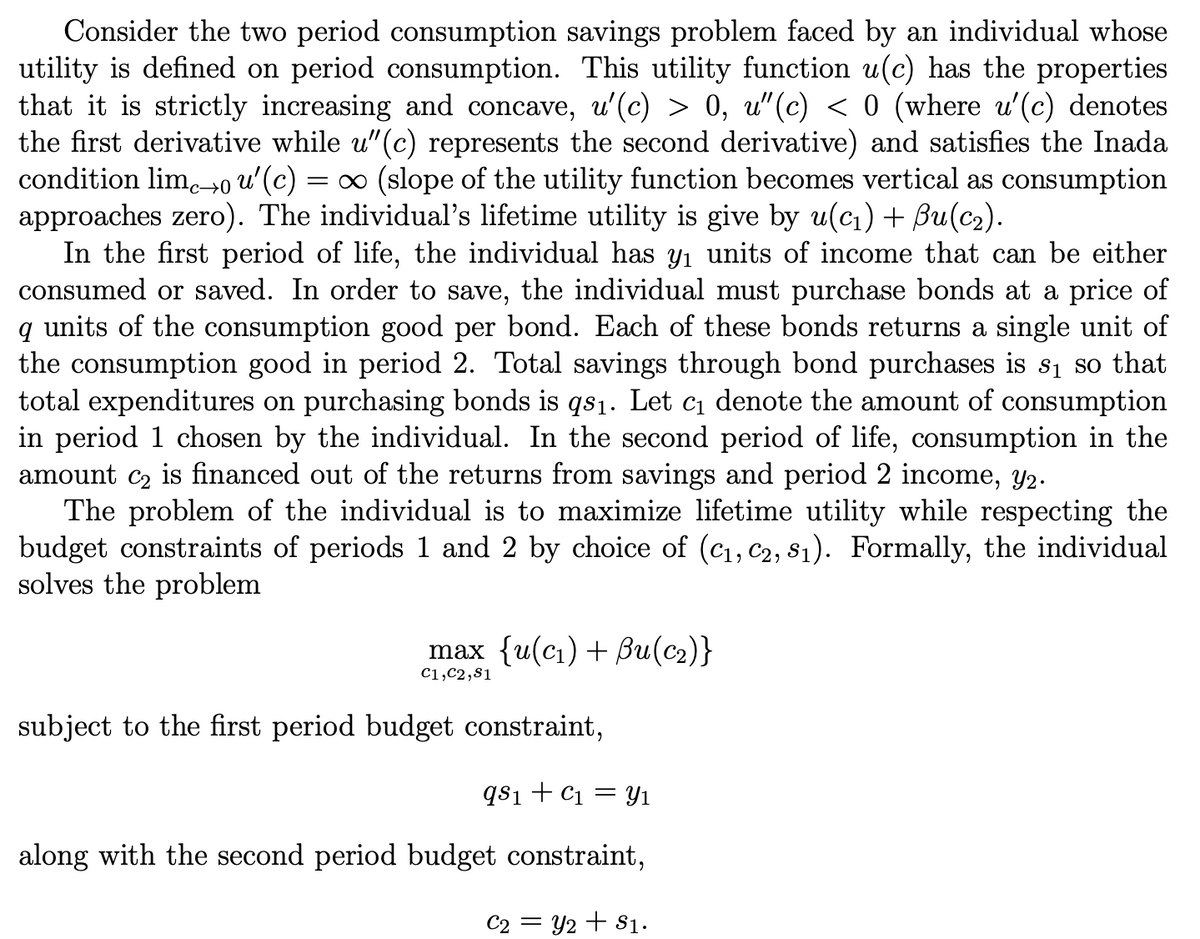Consider the two period consumption savings problem faced by an individual whose atility is defined on period consumption. This utility function u(c) has the properties hat it is strictly increasing and concave, u'(c) > 0, u"(c) < 0 (where u'(c) denotes he first derivative while u"(c) represents the second derivative) and satisfies the Inada condition lim.0 u'(c) = ∞ (slope of the utility function becomes vertical as consumption pproaches zero). The individual's lifetime utility is give by u(cı) + Bu(c2). In the first period of life, the individual has yı units of income that can be either !c→0 ngumod or sovod In ordor to govo the individuel must purchoso bonds ot o prieo of
Consider the two period consumption savings problem faced by an individual whose atility is defined on period consumption. This utility function u(c) has the properties hat it is strictly increasing and concave, u'(c) > 0, u"(c) < 0 (where u'(c) denotes he first derivative while u"(c) represents the second derivative) and satisfies the Inada condition lim.0 u'(c) = ∞ (slope of the utility function becomes vertical as consumption pproaches zero). The individual's lifetime utility is give by u(cı) + Bu(c2). In the first period of life, the individual has yı units of income that can be either !c→0 ngumod or sovod In ordor to govo the individuel must purchoso bonds ot o prieo of
Chapter17: Capital And Time
Section: Chapter Questions
Problem 17.1P
Related questions
Question
Using this functional form in the intertemporal trade-off condition that you previ- ously derived, do some algebra to obtain an equation that specifies how much the individual would save as a function of q, β, y1 and y2.

Transcribed Image Text:Consider the two period consumption savings problem faced by an individual whose
utility is defined on period consumption. This utility function u(c) has the properties
that it is strictly increasing and concave, u'(c) > 0, u"(c) < 0 (where u'(c) denotes
the first derivative while u"(c) represents the second derivative) and satisfies the Inada
condition lim.→0 u'(c)
approaches zero). The individual's lifetime utility is give by u(ci)+ Bu(c2).
In the first period of life, the individual has yı units of income that can be either
consumed or saved. In order to save, the individual must purchase bonds at a price of
q units of the consumption good per bond. Each of these bonds returns a single unit of
the consumption good in period 2. Total savings through bond purchases is s1 so that
total expenditures on purchasing bonds is qs1. Let c1 denote the amount of consumption
in period 1 chosen by the individual. In the second period of life, consumption in the
amount c2 is financed out of the returns from savings and period 2 income, Y2.
The problem of the individual is to maximize lifetime utility while respecting the
budget constraints of periods 1 and 2 by choice of (c1, C2, s1). Formally, the individual
solves the problem
= (slope of the utility function becomes vertical as consumption
max {u(c) + 8и(с2)}
C1,C2,81
subject to the first period budget constraint,
qs1+ C1 = y1
along with the second period budget constraint,
C2 = Y2 + S1.
Expert Solution
This question has been solved!
Explore an expertly crafted, step-by-step solution for a thorough understanding of key concepts.
This is a popular solution!
Trending now
This is a popular solution!
Step by step
Solved in 2 steps

Knowledge Booster
Learn more about
Need a deep-dive on the concept behind this application? Look no further. Learn more about this topic, economics and related others by exploring similar questions and additional content below.Recommended textbooks for you

